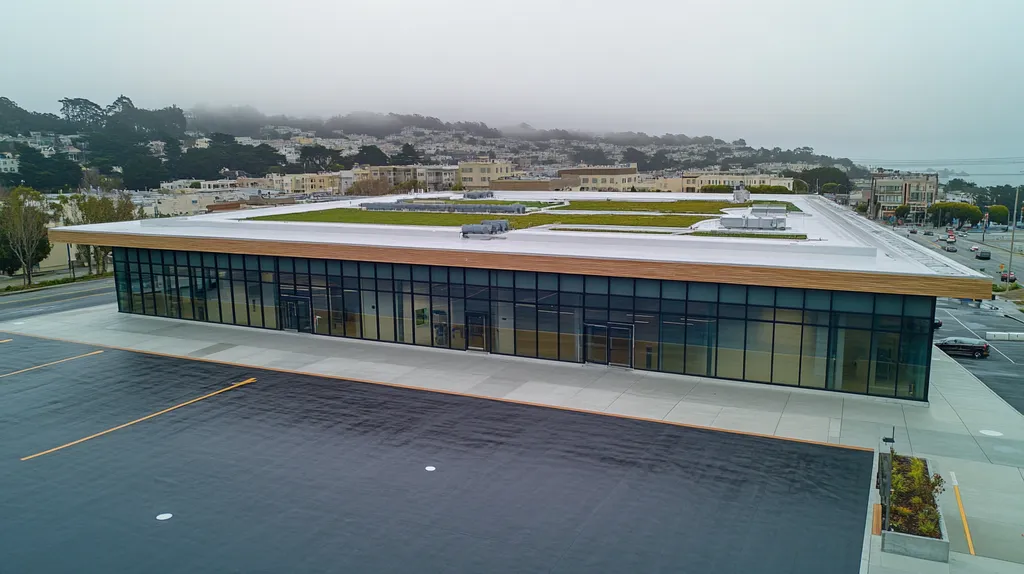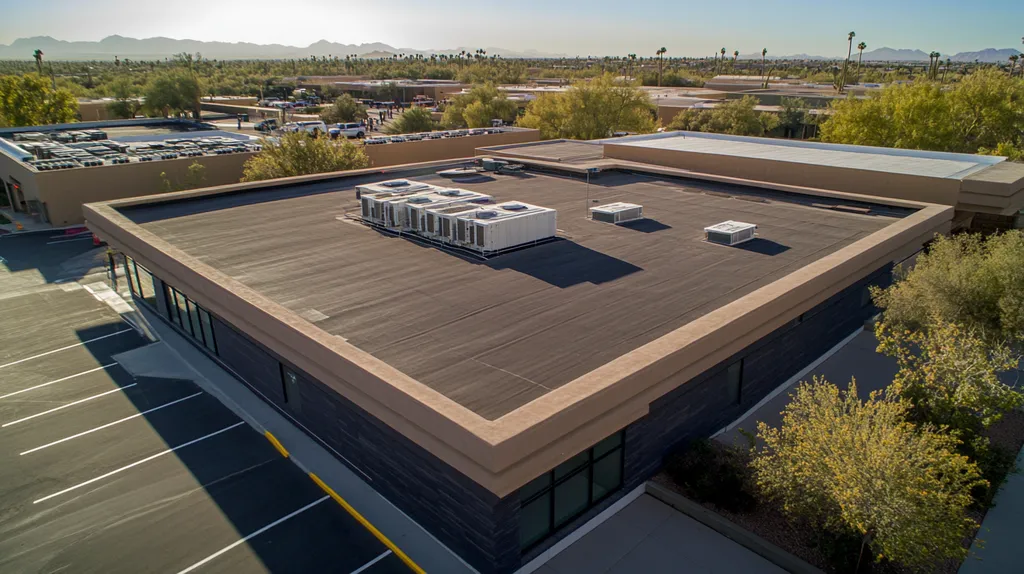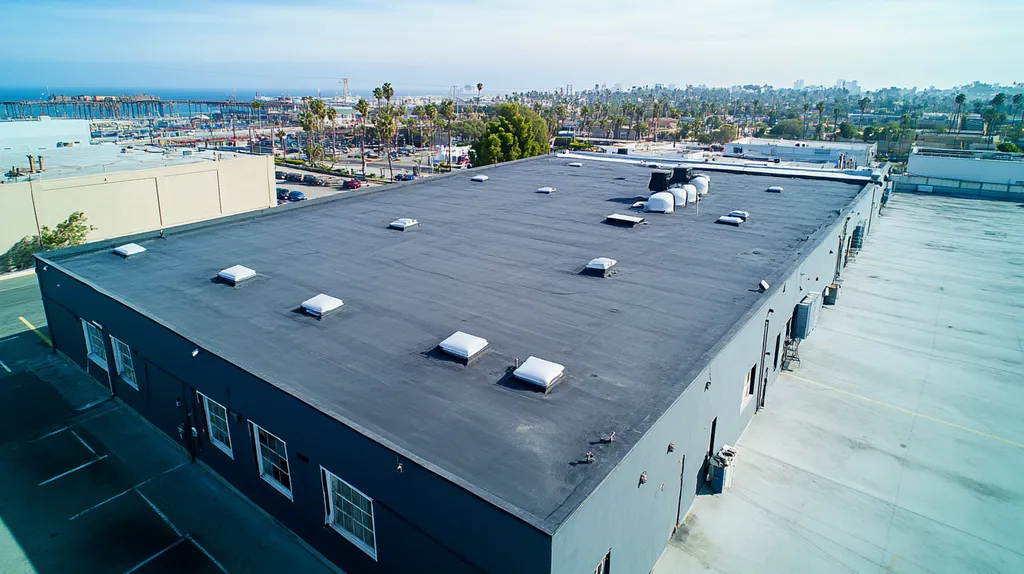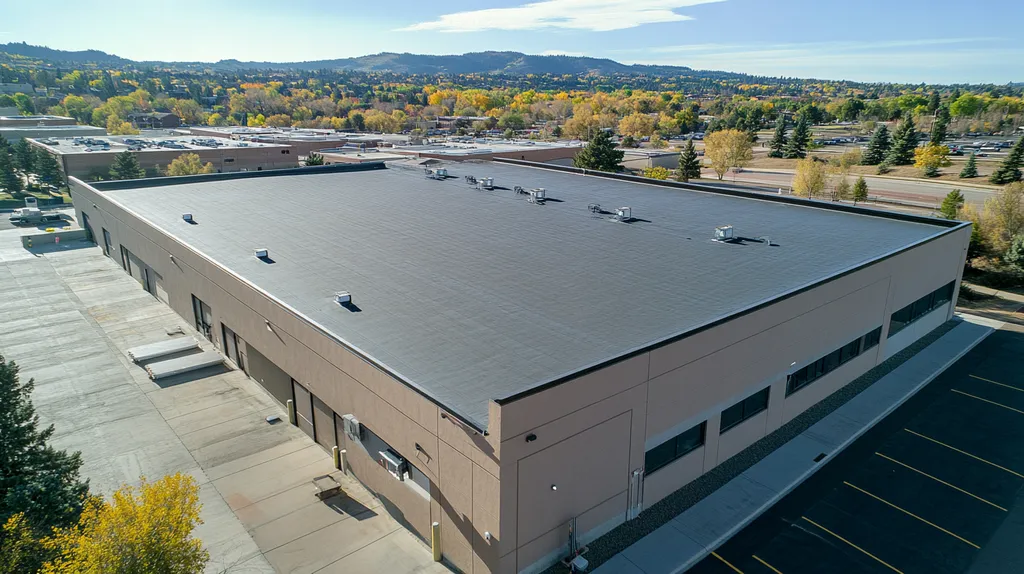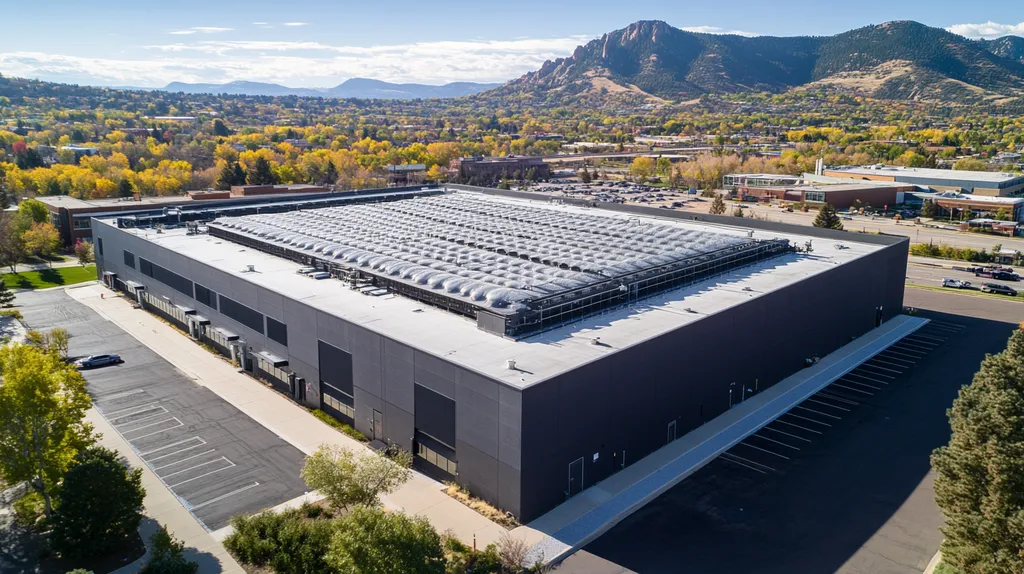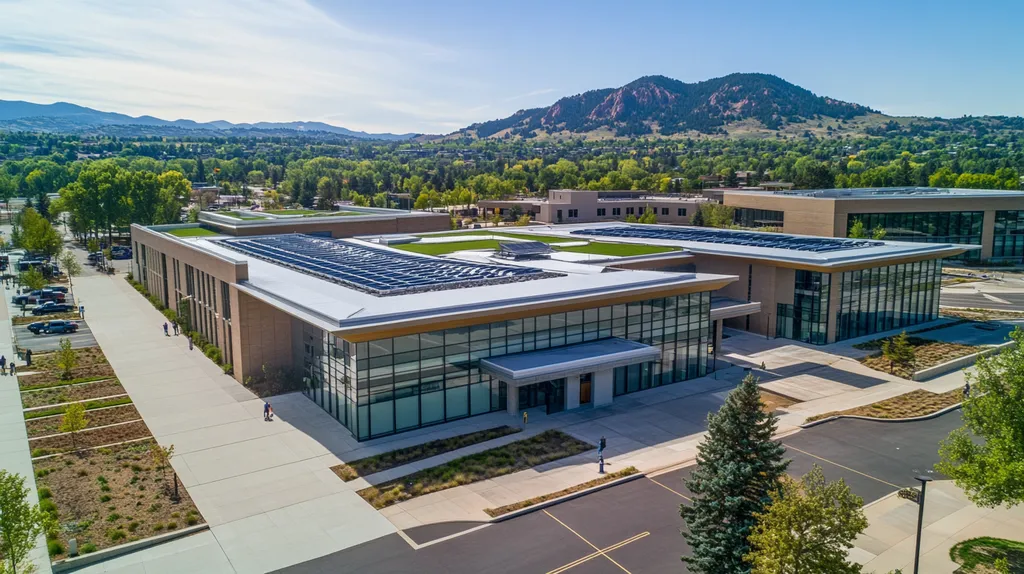Commercial roofing systems are experiencing an alarming 30% energy loss due to widespread insulation practices that prioritize cost over performance. This inefficiency costs property owners millions in preventable expenses annually while contributing to increased carbon emissions.
Current installation methods and material selections often fail to account for climate-specific requirements, resulting in premature system failures and reduced building efficiency.
This analysis examines the systemic issues plaguing commercial roof insulation, from inadequate R-value standards to missed opportunities in energy conservation, while presenting data-driven solutions for property owners and facility managers.
SECTION 1: CURRENT PRACTICES
The commercial roofing sector is grappling with significant challenges related to insulation for roof-mounted systems. Many property owners unwittingly select insulation materials and installation practices that can undermine energy efficiency and shorten the lifespan of their roofs. According to the U.S. Department of Energy, improperly insulated roofs can result in energy losses exceeding 30%, which can dramatically inflate operational costs. This section delves into the typical insulation materials, standard installation methods, and the importance of compliance with building codes, aiming to shed light on common pitfalls.
Common Insulation Materials Used
In the realm of commercial roofing, several insulation materials have emerged as industry standards. Polyisocyanurate, expanded polystyrene (EPS), and extruded polystyrene (XPS) dominate the market. Polyisocyanurate is known for its high R-values, but it may falter in environments with extreme moisture.
Meanwhile, EPS and XPS are praised for their moisture resistance, yet they may not provide the same level of thermal performance as polyisocyanurate. Each material brings its own advantages and drawbacks, and many property owners may not fully grasp how these factors influence overall roof performance.
The local climate is another crucial element influencing material selection. Areas with high humidity often require different insulation solutions compared to drier regions. Overlooking these climate-specific considerations can jeopardize the roof’s effectiveness.
Ultimately, the choice of insulation must align with both the environmental conditions of the installation site and the building requirements, ensuring optimal energy management.
Standard Installation Methods
Current roofing installation practices frequently involve methods that may neglect essential details. A common approach is using mechanically fastened insulation boards; while popular, this method may prove inadequate in terms of wind resistance.
Another method is adhesive bonding, which is often preferred for its straightforward application. However, if not executed properly, this technique can lead to loosening and detachment issues over time. Each installation method presents risks that can be reduced through meticulous attention to detail.
Additionally, the importance of properly compressing insulation layers cannot be overstated. If insulation lacks sufficient compression, air gaps can develop, diminishing thermal efficiency and increasing the likelihood of moisture intrusion.
A thorough review of installation methods underscores the necessity for consistency and adherence to best practices, which are essential for ensuring optimal roof performance and longevity.
Compliance with Building Codes
Building codes establish minimum standards for insulation in commercial roofing, yet compliance frequently falls short of maximizing energy efficiency. Many facilities settle for the minimum requirements to cut costs, which can lead to significant long-term financial implications.
The International Energy Conservation Code (IECC) outlines regulations aimed at improving energy performance, but adherence is often inconsistent. Numerous older buildings, built before stricter regulations were enacted, may still employ outdated insulation practices.
Moreover, assessing insulation performance based solely on initial costs detracts from effective long-term planning. Failing to account for future energy needs can result in escalating operational expenses.
Thus, building code compliance should not be viewed merely as a baseline requirement, but rather as a stepping stone toward more sustainable roofing solutions. Compliance with the most stringent regulations should be prioritized to ensure the highest levels of efficiency and performance in commercial roofing (source: Milwaukee Code of Ordinances).
SECTION 2: SYSTEMIC ISSUES
The current practices in commercial roof insulation expose critical flaws that can threaten building integrity and increase operational costs. Evidence shows that numerous roofing systems fail to achieve optimal thermal performance, leaving property owners vulnerable to escalating energy expenses and potential structural complications. Addressing inadequate insulation standards, moisture management, and fire safety is essential for the industry’s advancement.
Inadequate R-Value Standards
A significant challenge in the commercial roofing sector is the inconsistency in R-Value standards, which gauge insulation effectiveness. Current benchmarks often do not reflect real-world performance, leading property owners to invest in products that fall short of delivering promised energy savings.
For example, many commonly used insulation materials perform at only a fraction of their claimed R-Values in practical applications. This discrepancy can result in financial strain and unexpected maintenance costs as buildings struggle to maintain desired climate control.
Moreover, some jurisdictions adopt outdated standards that fail to incorporate advancements in insulation technology. This regulatory lag inhibits the use of improved products that offer enhanced thermal performance.
In summary, the lack of rigorous R-Value criteria not only misleads purchasing decisions but also contributes to increased energy consumption across the industry, undermining efforts to promote energy-efficient roofing solutions.
Moisture Resistance and Durability Gaps
Moisture resistance is a critical aspect frequently overlooked in commercial roof insulation. Insulation materials without proper moisture control can trap humidity, leading to deterioration over time—an issue particularly prevalent in humid climates where condensation is a constant concern.
Property owners should be aware that mold and rot can lead to substantial renovation costs. Insulation lacking moisture resistance places considerable strain on the entire roofing system, endangering structural integrity.
This quality control gap may stem from insufficient testing protocols during product development. Many manufacturers do not fully assess how their products withstand real-world moisture conditions, resulting in premature failures.
To reduce these risks, the industry must reevaluate grading systems for moisture resistance. Establishing more comprehensive standards will enhance durability and provide property owners with confidence in the longevity of their roofing investments.
Fire Safety and Regulatory Shortfalls
Fire safety remains a pressing issue that is inadequately addressed in many roofing insulation products. Existing regulations often do not include the latest fire-resistant technologies, putting commercial buildings at unnecessary risk. Some insulation materials that ignite during testing fail to meet current safety standards yet continue to see widespread use.
This regulatory gap can result in catastrophic consequences, endangering lives and properties. Property owners may operate under a false sense of security, mistakenly believing that compliance guarantees safety.
Furthermore, some regions lack rigorous oversight in enforcing fire codes. As a result, subpar materials are installed, jeopardizing overall building safety.
To address these shortcomings, the industry must adopt more stringent fire safety regulations for roofing insulation. By raising safety standards, stakeholders can enhance protection, reduce liabilities, and ultimately safeguard both investments and lives.
SECTION 3: MISSED OPPORTUNITIES
The current practices in commercial roof insulation are critically inadequate, resulting in missed opportunities for substantial energy savings and enhanced sustainability. An astonishing 30% of a building’s energy can escape through a poorly insulated roof, underscoring the need for property owners to reassess their insulation strategies. This section explores the untapped potential for energy efficiency, the pitfalls of ignoring climate-specific solutions, and the long-term cost savings that could significantly benefit building operators.
Energy Efficiency Potential Unmet
The energy efficiency opportunities within commercial roofing are significantly underexploited. Conventional insulation methods often fail to optimize thermal performance, leading to heat loss during winter and excessive heat gain during summer. Transitioning to high-performance insulation materials can dramatically lower energy consumption.
Research indicates that energy-efficient roofs can reduce heating and cooling expenditures by up to 30%, yet many facilities persist with outdated insulation methods. This not only strains operating budgets but also exacerbates greenhouse gas emissions.
Furthermore, neglecting advanced insulation technologies means missing out on the financial rebates and incentives aimed at promoting energy-efficient upgrades. Utilizing these financial offsets can enhance return on investment, making improvements more feasible.
Additionally, inefficient insulation adversely affects indoor comfort, which in turn can harm employee productivity and satisfaction. It is crucial for property owners to factor in not only the initial costs but also the long-term advantages of adopting energy-efficient insulation solutions.
Neglect of Climate-Specific Insulation
A prevalent oversight in commercial roofing is the tendency to apply a one-size-fits-all insulation approach. Each geographical region presents distinct climate challenges requiring tailored insulation solutions for effective performance. For example, buildings in cold climates necessitate insulation that combats moisture and ice buildup.
In contrast, facilities in warm and humid regions require insulation that can endure high temperatures and minimize thermal bridging risks. Overlooking these climate-specific factors can lead to subpar performance and increased energy costs.
Employing generic insulation materials across various climatic zones can have far-reaching consequences on energy efficiency and durability. It is essential to understand local climate characteristics when selecting insulation types to achieve optimal performance under diverse weather conditions.
Utilizing innovative insulation products tailored for specific climates can significantly enhance a building’s energy profile, furthering sustainability goals while ensuring superior comfort and efficiency.
Overlooking Long-Term Cost Savings
While initial costs may capture the attention of property owners, the long-term savings associated with high-quality insulation far surpass these upfront investments. Well-insulated roofs lead to considerable reductions in energy expenditures, environmental impact, and ongoing maintenance costs over time.
A properly insulated roof not only lowers energy bills but also extends the lifespan of roofing materials, thereby reducing the frequency of early replacements or repairs. This durability translates into fewer disruptions and less operational downtime for businesses.
Moreover, energy-efficient buildings are increasingly attractive in the real estate market. Properties featuring superior insulation often command higher rental values and enhanced marketability, reflecting the rising demand for green building certifications.
Thus, the neglect of long-term cost savings exemplifies a broader industry issue—an inclination toward reactive rather than proactive roofing solutions. By strategically addressing insulation needs, property owners can protect their investments and enhance overall building performance.
SECTION 4: ROOT CAUSES
The sustainability and efficiency of commercial roof-mounted insulation are often jeopardized by fundamental issues that go unaddressed. Recent studies indicate that up to 30% of energy costs can stem from poor insulation choices, emphasizing the urgent need for property owners to recognize the significant ramifications of ineffective insulation practices. By identifying these root causes, stakeholders can take concrete steps towards enhancing their roofing systems.
Lack of Tailored Insulation Solutions
Many property owners gravitate towards generic insulation materials, overlooking the unique requirements specific to their buildings. Each commercial property possesses distinct characteristics that significantly influence its insulation needs, including climatic conditions, architectural design, and intended functionality. Adopting a one-size-fits-all approach can lead to inadequate thermal performance, ultimately compromising energy efficiency.
When these tailored factors are neglected, insulation efficiency suffers, resulting in unwanted energy loss that affects both comfort levels and operational costs. Tailored insulation solutions are vital to maximize energy efficiency and meet the exact demands posed by each roofing system.
Additionally, inappropriate insulation materials can lead to structural damage over time. Moisture retention and condensation issues are common when insulation does not align with a building’s specific environmental conditions. Therefore, investing in customized insulation solutions is essential for promoting the longevity and durability of the roofing system.
In summary, property owners must engage with specialized consultants before making insulation decisions. This proactive approach will lead to improved energy efficiency and significant long-term cost savings.
Insufficient Training for Installers
The effectiveness of insulation systems is fundamentally tied to the quality of installation, yet many roofing professionals lack sufficient training in contemporary insulation techniques and materials. This knowledge gap can lead to improper application, severely diminishing the overall effectiveness of the roofing system.
Common installation errors often arise from misunderstanding insulation types and their appropriate applications. For instance, confusing rigid foam insulation with blanket insulation can result in inadequate thermal performance and compromised moisture control. Such oversights underscore the critical need for continuous education and training for installers.
Moreover, the rapid advancements in insulation technology necessitate that roofing professionals receive ongoing training and certification. Without updated knowledge, installers may revert to obsolete practices, jeopardizing the energy efficiency of the buildings they work on. Consequently, the industry must prioritize improved training initiatives to ensure installers are well-equipped to implement modern technologies effectively.
In conclusion, addressing the issue of insufficient training for installers will enhance installation quality and contribute to better insulation performance throughout the commercial roofing sector.
Budget Constraints Overriding Performance
Financial constraints frequently compel property owners to prioritize immediate savings over long-term performance. Many decision-makers instinctively choose the least expensive insulation options, neglecting to consider their lasting implications. This short-sighted approach can lead to increased energy costs and persistent maintenance challenges in the future.
When budget considerations take precedence over insulation choices, crucial performance elements are often disregarded. For example, opting for lower-cost materials may result in short-term savings but will ultimately contribute to greater operational costs due to subpar thermal performance. This choice rarely provides good value over the long haul.
Furthermore, those responsible for managing roofing projects may lack the necessary insights to make informed decisions that balance budget constraints with performance needs. The industry must enlighten these stakeholders about the benefits of investing in high-quality insulation, as initial costs can often be mitigated through energy savings and reduced repair expenses.
Ultimately, fostering a culture that emphasizes long-term performance over immediate savings will lead to more effective commercial roof insulation practices. Property owners should view insulation as an investment, not merely an expense, thereby ensuring their buildings continue to operate efficiently and effectively for years to come.
DATA DRIVEN EVIDENCE
With rising energy costs and a growing emphasis on sustainability, the need for effective commercial roof insulation has never been more pressing. Studies indicate that proper insulation can achieve energy savings of up to 30% annually for commercial buildings. This section will explore critical energy savings metrics, compare different insulation types, and showcase real-world case studies that highlight the necessity for a thorough reassessment of current insulation practices.
Energy Savings Metrics and Studies
A variety of studies have focused on the energy savings possible with proper roof insulation. The U.S. Department of Energy, for example, reveals that well-insulated buildings can achieve energy savings in the range of 20% to 30%. These savings represent significant reductions in operational costs over a roof’s lifespan.
Moreover, buildings installed with advanced insulation technologies, such as spray polyurethane foam or reflective membranes, see substantial reductions in heat transfer. This directly translates to lower energy demands on HVAC systems, resulting in decreased costs.
Analyzing the return on investment (ROI) for upgrading insulation reveals that initial expenditures are frequently recuperated within a few years as energy bills diminish. Recognizing these metrics is vital for property owners to make informed, effective roofing decisions.
In addition to immediate cost savings, energy-efficient insulation contributes to long-term ecological sustainability, benefiting both property owners and the environment.
Comparative Analysis of Insulation Types
The effectiveness of different insulation materials can lead to vastly different energy efficiency outcomes. Rigid foam boards, for instance, are known for their high thermal resistance but typically come with a higher initial price tag. Conversely, fiberglass batts, while more economical, often fall short in performance, particularly in non-standard roof shapes.
Reflective insulation, designed to reflect radiant heat, has gained popularity in commercial applications. Studies show that it can reduce cooling costs by as much as 20%, making it especially beneficial for buildings located in warmer climates.
In many cases, combining diverse insulation types yields optimal performance. A hybrid approach may capitalize on the strengths of various materials while compensating for individual weaknesses, enhancing overall energy efficiency.
This comparative analysis underscores the importance of meticulous evaluation when choosing insulation. Making informed selections can lead to notable operational savings and improved comfort within buildings.
Real-World Case Studies and Outcomes
Real-world case studies vividly illustrate the transformative potential of effective insulation in commercial properties. For example, one warehouse upgraded its roof insulation and enjoyed a remarkable 25% reduction in annual energy expenses, making the property significantly more attractive to potential tenants.
Another case study involved a national retail chain that implemented reflective roof insulation across its locations. The chain reported an average cooling cost reduction of 18%, underscoring the critical role of proper insulation in energy management strategies.
These case studies reveal that thoughtfully selected insulation can lead to meaningful improvements, not only in energy savings but also in operational efficiency. The implications for property owners are considerable, reinforcing the necessity of re-evaluating current insulation methods.
Consequently, these real-world outcomes reaffirm the essential role insulation plays in optimizing energy performance, emphasizing the importance of informed decision-making in roofing strategies.
SECTION 6: ALTERNATIVE SOLUTIONS
As the urgent demand for energy efficiency escalates, the limitations of traditional insulation methods in commercial rooftop systems become increasingly apparent. Research indicates that nearly 30% of a building’s energy is lost through its roof, underscoring the necessity for innovative approaches. This section explores advanced insulation materials, optimized installation techniques, and integrated designs as compelling alternatives to standard insulation practices.
Advanced Insulation Materials and Technologies
Emerging insulation materials, such as vacuum insulation panels (VIPs) and phase change materials (PCMs), provide significant advantages in thermal performance compared to conventional options. VIPs offer exceptional thermal resistance while requiring minimal space, thus maximizing valuable rooftop area.
PCMs function by absorbing and releasing thermal energy, effectively stabilizing indoor temperatures and promoting comfort. By integrating these advanced materials, commercial structures can achieve substantial reductions in energy consumption and enhance overall occupant satisfaction.
Additionally, reflective insulation plays a crucial role in minimizing heat absorption in warm climates. This characteristic not only lowers cooling costs but also contributes to a longer lifespan for roofing systems.
Implementing these innovative solutions represents a transformative shift in how commercial properties approach insulation, promoting sustainability and cost efficiency.
Optimized Installation Techniques and Systems
Enhancing installation efficiency is just as critical as selecting high-quality materials. Traditional installation methods often result in gaps and inconsistencies that degrade insulation performance. By utilizing advanced application techniques, such as adhesive bonding for insulation boards, a more effective seal can be achieved, leading to superior energy retention.
Moreover, prefabricated systems streamline the installation process. Designed for easy assembly, these systems reduce labor time and minimize on-site errors. As a result, they not only lower overall project costs but also enhance the performance of the building.
Proper training for installers on the latest application methods also ensures adherence to best practices. By addressing potential installation pitfalls, the industry can deliver more effective and durable roofing solutions.
Collectively, these optimized techniques promote efficient use of both labor and materials, resulting in significant cost savings throughout the lifecycle of the roof.
Integrated Roofing and Insulation Designs
The traditional separation of roofing and insulation functions is becoming increasingly obsolete. Integrated designs that marry roofing materials with insulation provide a comprehensive approach to maximizing energy efficiency. Systems that incorporate roofing membranes with built-in insulation minimize thermal bridging and enhance overall system performance.
These integrated solutions simplify the design and construction processes, reducing material costs and limiting potential vulnerabilities within the roofing system. Consequently, buildings benefit from improved thermal performance and reduced energy expenditures.
Additionally, advanced modeling technologies can optimize these integrated systems, enabling property owners and managers to visualize potential energy savings prior to installation. This approach fosters informed decision-making and encourages the adoption of more effective roofing solutions.
Through advancements in integrated designs, commercial properties can pursue elevated energy efficiency while simultaneously decreasing their environmental footprint.
Moving Forward
The data is clear: current commercial roof insulation practices cost property owners millions in preventable energy losses while contributing to increased carbon emissions across the building sector.
Studies show that implementing advanced insulation solutions, combined with proper installation techniques, can reduce energy costs by up to 30% annually for commercial properties.
Without immediate industry-wide changes to address systemic issues like inadequate R-value standards and insufficient installer training, these inefficiencies will continue to burden property owners with excessive operational costs.
The adoption of climate-specific solutions, integrated designs, and emerging materials like vacuum insulation panels represents a critical path forward for the commercial roofing sector.
Property owners who fail to embrace these advancements risk falling behind in both energy efficiency and market competitiveness.
FREQUENTLY ASKED QUESTIONS
Q. What current insulation practices are common for commercial roofs?
A. Many property owners choose common materials like polyisocyanurate, EPS, or XPS for insulation. Each material has advantages and drawbacks, particularly regarding energy efficiency and durability. Insulation selection must consider local climate conditions and building codes for optimal roof performance.
Q. How do systemic issues affect commercial roof insulation?
A. Systemic issues like inadequate R-Value standards and poor moisture management undermine insulation effectiveness. Compromised thermal performance may lead to increased energy expenses and potential structural damage. Improving these fundamentals is essential for better operational efficiency in commercial properties.
Q. What energy efficiency potential exists for commercial roofs?
A. Commercial roofing often underutilizes energy efficiency opportunities, with poor insulation leading to excessive heat loss. High-performance insulation can cut energy expenditures significantly. Property owners need to recognize the long-term benefits of modern insulation technologies to optimize their building’s efficiency.
Q. What root causes lead to ineffective insulation practices?
A. Common root causes include a lack of tailored insulation solutions and insufficient training for installers. Generic materials often fail to meet specific building needs, which can compromise energy efficiency and incur long-term costs. Specialized knowledge is crucial for effective installation practices.
Q. What evidence supports the need for better commercial roof insulation?
A. Numerous studies indicate that effective roof insulation can yield energy savings up to 30%. Higher thermal resistance materials can significantly reduce operational costs while enhancing overall building performance. Analyzing real-world outcomes further emphasizes the need to reevaluate current insulation practices.
Q. What alternative solutions exist for commercial roof insulation?
A. Innovative solutions include advanced insulation materials like vacuum insulation panels and phase change materials. Optimized installation techniques and integrated designs also significantly enhance energy efficiency. These modern alternatives promote sustainability while addressing the limitations of traditional insulation methods.
Q. How can I assess the long-term cost savings of my roof insulation?
A. To evaluate long-term savings, consider total energy consumption changes and maintenance costs. An upgraded insulation system may require higher upfront costs but significantly reduces ongoing operational expenses. Tools like energy modeling can help estimate long-term benefits aligned with insulation improvements.

